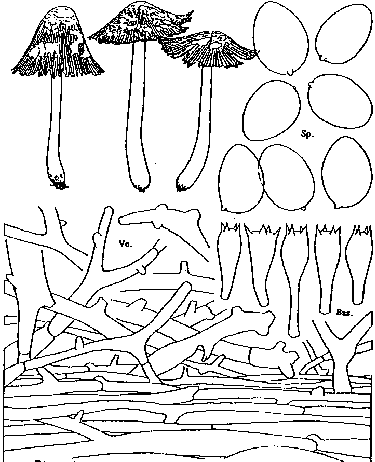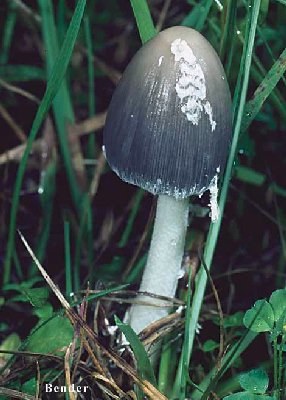Macroscopic features |
Pileus 15-40 x 10-25 mm when still closed, ellipsoid or ovoid, first whitish, soon pale greyish or beige, cream-beige (Mu. 2.5 YR 7/2 to 10 YR 5/3; K. & W. 4B3 to 5D3), later with beige, greyish ochre or ochre-brown tinges. Veil at first whitish then splitting up in greyish beige to ochre-brown patches, the last particularly on disk. Lamellae very crowded, free, first whitish, then brownish, later grey-brown to dark grey, finally black. Stipe up to 120 x 3-10 mm, slightly attenuate upwards, white or grey-white, minute woolly fibrous, in particular at base. |
Microscopic features |
Spores [60,3,3] 8.6-12.6 x 6.1-8.9 µm, ovoid or ellipsoid, rounded to somewhat acute at apex, very dark brown, with central, c. 1.5 µm wide germ pore; Q = 1.25-1.65, av. Q = 1.40-1.50; av. L = 10.1-11.4, av. B = 6.9-8.0 µm. Basidia 18-47 x 8-13 µm, 4-spored, surrounded by (4-)5-7(-8) pseudoparaphyses. Pleurocystidia 75-165 x 21-50 µm, ellipsoid, oblong, utriform, narrowly utriform or cylindrical. Cheilocystidia 50-135 x 18-45 µm, utriform, ellipsoid, oblong or broadly conical. Elements of veil thin-walled, diverticulate, up to c. 100 x 4-8(-11) µm thick. Clamp-connections present. |
Habitat & distribution |
Solitary or a few together, in dry limestone grasslands. Very rare in the Netherlands and Belgium, rare in Germany. Usually found on calcareous soil. In the Netherlands mainly found in the South of prov. Limburg on chalky loam. |
Remarks |
Coprinus stanglianus is rather similar to C. picaceus, but that species has distinctly larger spores and somewhat larger basidiocarps. Macroscopically also C. kimurae is close but that species has smaller spores of different shape. |

[Copyright © by ]

[Copyright © by Hans Bender jbe8995374@aol.com]